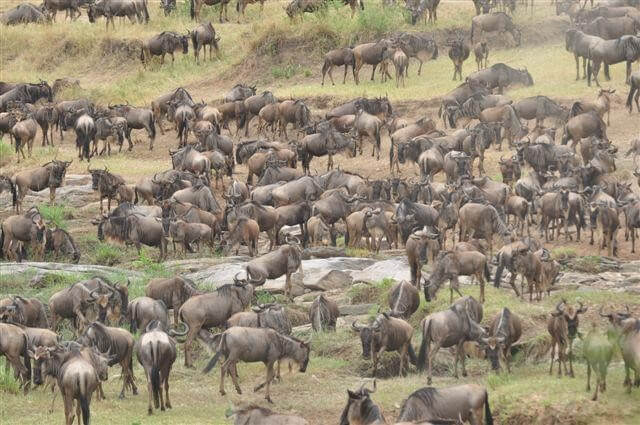Every year, more than two million animals make an incredible journey through Tanzania and Kenya in search of fresh land to graze and water to drink. They migrate on this clockwise path on ancient instinct, which helps them to follow the same route despite the hardships that await them on it. Wildebeest for the most part, the horde also includes zebra and gazelles, and the predators who stalk them. If you want to experience this amazing sight, you have to plan carefully. Here’s our guide so you can experience the wildebeest migration at its best.
January
When the year begins, the herds are on the Serengeti in Tanzania. They start out in the north-east region and gradually move south towards the Ndutu and Ngorongoro Conservation areas. This is calving season, so it’s often a wonderful opportunity to see baby calves wandering around. However, this is also when the herds are at their most vulnerable to predators, who are always waiting to swoop in and take the new-borns. They will be able to stay here in the far south until all of the grasses have been grazed and the last calves are born, in late March. With this said, word of warning if you’re not comfortable seeing nature eat nature it would best to visit at a later time in the year.
April
Now the wildebeest begin to move northward, through the central and western areas of the Serengeti. They are ready to start the first leg of their migration, and you can follow them with mobile camp expeditions. They form huge columns which can stretch across as much as 40km at a time, as the large herds funnel in towards the same area. The toughest part of the journey begins in the next few months, so this is a great opportunity to see the large scale of the migration without having to witness the more distressing moments so often.
July
This is the event that many people associate most closely with the migration: The river crossings. The herds have to make the perilous crossing over the brown swollen rivers, but the Nile crocodiles are waiting for them. Many of the young calves will be picked off here, and others may be swept away by the rushing waters. The herds try to cross en masse, finding safety in numbers, but it isn’t always easy. When they make it through, the survivors will mass on the northern part of the Serengeti and feast before moving on. It is certainly a spectacle to see and is one of the best times of the year to see the wildebeest migration.
August
August is also a great month to have safari tours in Kenya! The Masai Mara National Reserve is the famous destination for their new travels. If you are following along with them don’t forget that you will need to pass through border controls. After this month the herds will start to split up into smaller groups and find their own grazing lands, and they will stay around this area until October when they move back up to their previous grounds. This is a popular time for visitors and you can see the wildebeest peacefully spending time in the Masai Mara and the northern Serengeti. Here you will also find the tribal peoples of the Maasai, another interesting draw which you can discover more about here.
Whichever part of the migration you witness, you will find it to be a truly unforgettable experience like nothing else on earth. Witnessing nature up close is a real eye opener you shouldn’t miss out on.






